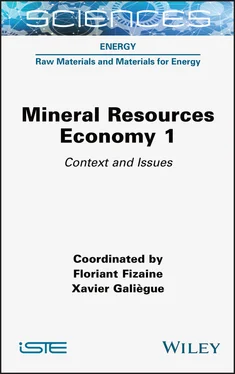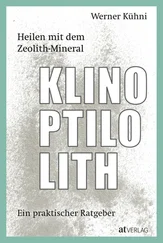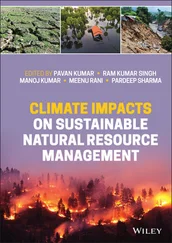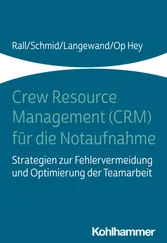ISTE Ltd
27-37 St George’s Road
London SW19 4EU
UK
www.iste.co.uk
John Wiley & Sons, Inc.
111 River Street
Hoboken, NJ 07030
USA
www.wiley.com
© ISTE Ltd 2021
The rights of Florian Fizaine and Xavier Galiègue to be identified as the authors of this work have been asserted by them in accordance with the Copyright, Designs and Patents Act 1988.
Library of Congress Control Number: 2021935806
British Library Cataloguing-in-Publication Data
A CIP record for this book is available from the British Library
ISBN 978-1-78945-024-8
ERC code:
SH1 Individuals, Markets and Organisations
SH1_12 Agricultural economics; energy economics; environmental economics PE10 Earth System Science PE10_10 Mineralogy, petrology, igneous petrology, metamorphic petrology
Florian FIZAINE1 and Xavier GALIÈGUE2
1IREGE, Savoie Mont Blanc University, Annecy, France
2LEO, University of Orléans, France
Why did we write a book on the economics of mineral resources? As economists, we would be tempted to say that the absence of a French title on the subject was the motivation for the very existence of the original French edition of this book. Nevertheless, this answer might seem rather sketchy, since there are so many reasons for the creation of this collective work.
To begin with, there are the foundations and knowledge accumulated on the subject over decades by researchers from different disciplines. This knowledge and these representations conveyed through more specialized articles and books convince us of the issues related to the theme. As we will see later, these issues are of various kinds: environmental, social, economic and so on. This knowledge questions us too. Sometimes by its originality, more often by its gravity, it urges us to deepen the field of knowledge to better understand causes, mechanics and consequences and, potentially, to propose levers of action.
Then there are the gaps, shadows and persistent mysteries around the theme. Some of these disappear with the accumulation of work in a discipline and the renewed interest of researchers in understanding what cannot be easily explained. Others – and this is particularly the case for problems associated with our book – are illuminated thanks to the cross-fertilization of several disciplines, with which we are able to fully grasp the intricacies of complex problems, but above all thanks to the interdisciplinary toolbox that can unravel them.
These reasons, although important, are not specific to mineral resources. Therefore, a detour through different time horizons may shed some light on the role of these particular resources for human civilizations. We shall then see in what particular context they come into play.
I.1. Why are mineral resources important?
Observation of the past can provide welcome insights. If we had been able to measure the material footprint of Homo sapiens in the early days, we would probably have been able to see that they relied only very partially on mineral resources, with the possible exception of the manufacture of tools such as flint or the bifaces inherited from their ancestors. History evolved radically with the passage of the Neolithic revolution. The three characteristics of this revolution – sedentarization, the production economy and the adoption of a new form of social organization – are still debated among researchers, particularly with regard to their simultaneity.
However, this “new stone age” (also called Neolithic) was accompanied by a renewal in the consumption of materials because a sedentary lifestyle, agriculture and the development of denser settlements required more resources. The role played by polished stone (like axes) therefore intensified. Pottery, although pre-dating the Neolithic period, also served as a cornerstone for the development of trade. The surpluses generated by agriculture allowed for a first step towards the specialization of tasks and certain types of resources (tools and other rare resources) could then be distributed where they were lacking via a vast network of exchange controlled by the elites, producing an extension of the human frontier (Barbier 2011). Humans thus generated the first profound modification of their environment. Later, technical innovations based on the mastery of extraction and the isolation of new mineral resources marked history, through the Bronze Age (3000 BCE) and then the Iron Age (1200 BCE).
Although the extraction of these mineral resources became more widespread and was, therefore, an integral part of the development of human civilizations, minerals remained a scarce resource. For example, the price of iron in the eponymous era varied at that time between eight times the price of gold and twice that of silver (Virolleaud 1953). In the 17th and 18th centuries, another revolution, that of industry, was born at the same time as the massive extraction of another mineral resource: coal. The civilizations of Europe then moved from agricultural and artisanal societies to industrial societies, and thus withdrew a little more from the rhythm imposed by the biosphere.
This mastery of a new form of energy from a more abundant and concentrated stock than biomass, accompanied by the development of knowledge (physics and chemistry), gave rise to a new surge in the production/consumption of mineral resources. For example, the production of copper rose from 216,500 tons per year in 1800 (about the level of the Roman period) to more than 500 kt per year in 1900 (Hong et al. 1996). This century also marked the discovery of new elements that expanded the seven metals known since Antiquity. Finally, the generalization of industrialization and of the Western way of life spread throughout the world from the contemporary period (since 1945), leading to another leap in the consumption of already existing mineral resources, as well as to a surge in the production of small metals that had hitherto remained confined to the role of curiosities. However, this last period, although recent, brought with it a new and deep mark of humans in their environment. The latter itself became the primary force of change for the geosphere, the biosphere and the climate. Is history moving into a new era – the Anthropocene (Steffen et al. 2015)? While the opening of a new era is still under debate, it is clear that a look back leads us to believe that each time humans free themselves a little more from the constraints and temporalities that their environment places on them, they do so by making more intense use of mineral resources.
Beyond the past, mineral resources also shape the present. If the climate crisis remains, at first glance, regularly associated with an increasing use of fossil resources (coal, gas and oil), a more seasoned analysis, like that of historian V. Smil (2013), shows that a great part of this energy is dedicated to the extraction, production and provision of material resources for the economy. Thus, according to his book, 20% of the world’s primary energy is used for the production of materials, including 13% for mineral resources alone (10% for metals and 3% for construction materials), which is roughly the size of the United States in the world’s primary energy consumption. This major role of mineral resources in energy consumption is closely related to their environmental impact in terms of greenhouse gases (GHGs), insofar as the energy used remains predominantly carbon-based (Mudd 2010; Northey et al. 2013). Our relationship with mineral resources is, therefore, not unrelated to the current climate crisis and other environmental issues .Indeed, the latest UNEP report (2019) indicates that the predominance of metals in the environmental impacts of natural resources. Thus, metals account for 18% of the impacts in terms of greenhouse gases related to resources and 39% of the effects of particles on health and the environment. Other non-metallic mineral materials, although representing the bulk of the mass and experiencing the strongest growth, generate less environmental stress on a global scale (less than 2% of total resources), though there are exceptions here again, particularly when looking at cases of local degradation. Most of the impact of this other important category of mineral resources today comes from their use in cement and fertilizer production.
Читать дальше












